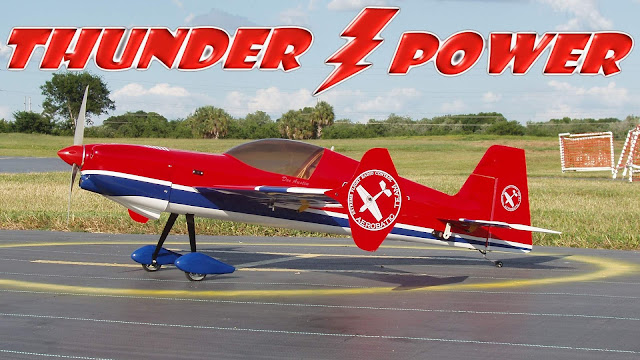My solitary red MXS has been hanging on the ceiling for over two years because I have had so many other great EXPs to fly. Of course, I also flew a few of the blue MXS too, but the red has always been a special plane for me. I guess I was saving it, but now that I have a back up, I hope to get out with this plane much more often.
My first red MXS and I survived a heart attack together. While I was in the hospital I couldn't wait to get out of there so I could go home and order another one! Unfortunately by then, they were out of stock, but that just led to my first Extra EXP.
Most Extreme
All of the EXP series planes share a lot of flight characteristics. They are all designed to do achieve the same thing, which is extreme aerobatics, so the differences are all fairly subtle, and I fly them all pretty much the same way.
Except the MXS, that is.
What separates the MXS from the rest is that it is designed to fly even more extreme aerobatics than the rest. The moment (the distance between the wing and the horizontal stabilizer) is the shortest of all the EXPs, and at the time of it's release, the MXS had the largest elevator.
If you add the Dubro heavy duty servo arm on the elevator, you can get over 90 degrees of deflection. I use the second from the outside hole on the Dubro arm and crank my end points. That will give me about 88 degrees of throw, and believe me, when you yank on the elevator the MXS delivers.
The design of the MXS coupled with all that throw gives it nearly obscene pitch authority that makes for spectacular wall and parachute maneuvers. Most planes will climb a little when you pop them up into a wall maneuver. The MXS, however, rotates so hard that both wings stall instantly, and the plane will stand up on it's tail and actually sink toward the ground. I have bounced the MXS off the runway with the back of the rudder a time or two doing my walls a little too low, and I have to remember to start the wall higher than I want because it's going to drop some. That, and lately I have started adding power to arrest the sinking.
As you can well imagine, this means you have to fly the MXS a little differently, but it is not scary or anything. It's just different and after a flight or two you get used to it. I've found that I get the most out of the MXS when I dedicate myself to the plane and fly nothing else. I can jump around to the others with no trouble, but the MXS is another level of extreme and you have to fly it that way.
Most MXS pilots love the plane for it's tumbling ability. The plane does lovely snaps and I've been working on a double snap, turning the plane 180 degrees from direction entry and coming back in an elevator. It's just a turnaround move and the MXS looks really lovely doing them.
Inside and outside snaps are very crisp, though with all the elevator throw you get a cleaner maneuver using about half the travel. There is so much pitch authority that if you use it all in a snap the plane will rotate so hard that it will turn itself out of it. It will just sort of look like it is wallowing through, but if you work on your snaps you'll get the timing right and the elevator movement will become natural. All 3D planes are like this in that they snap better without using so much elevator, but the MXS is a little different because it's elevator is so much more effective that you use less of it in a snap.
The MXS' big surprise is that for all of it's violence, the plane is still very, very capable of buttery smooth precision work. You can see my big sky stuff looks very nearly as good as what I do with an Extra. Even with all that pitch authority, the MXS still has a big enough fuselage, fin, stabilizers, and SFGs to generate lift for good 3D, and locked in grooving at high speed.
I hope to be doing a lot more with the MXS this fall. There are so may good EXPs that it is hard to just take one of them and fly it extensively until you learn all it's intricacies. I wish I could pick one and stick with it for awhile, but I just like all of them too much for that.
Bonus Footage!
Below is some footage from last year that I edited before with Windows XP Movie maker, and I have since learned that's a very low resolution editor. After re-editing with Windows Seven, it turns out this was HD footage and it is much, much better than before and worthy of a repost.
These were all taken in either blindingly bright conditions, or in near darkness, but they are still beautiful. You just need to turn off the lights to get the best viewing. The sunset video is especially pretty, but you will want to watch that one in a dark room so the colors will come out better.
These were all taken in either blindingly bright conditions, or in near darkness, but they are still beautiful. You just need to turn off the lights to get the best viewing. The sunset video is especially pretty, but you will want to watch that one in a dark room so the colors will come out better.











